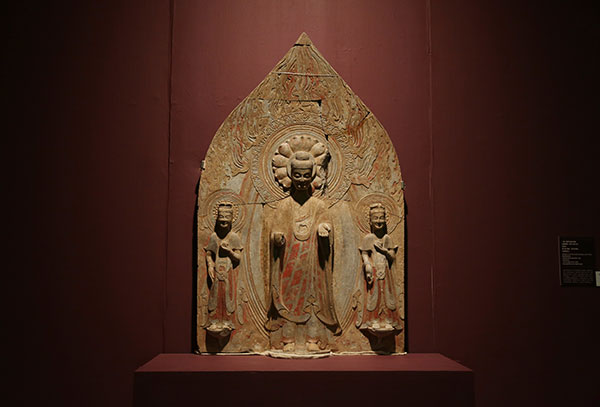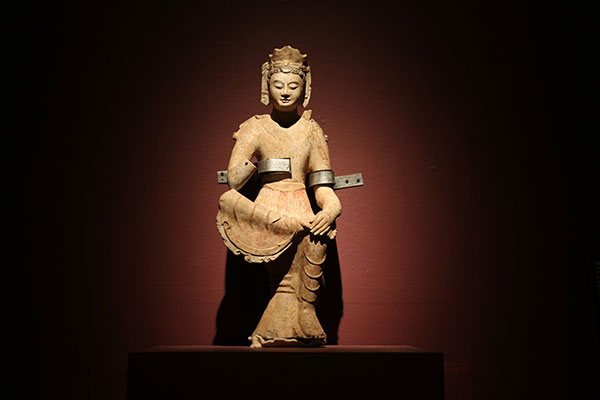Buddhist relics unearthed in Qingzhou, Shandong province, were among the country's top 10 archaeological discoveries in 1996.[Photo provided to China Daily]
Exhibition curator Zheng Yan, who is also a professor of cultural heritage at the CAFA, had mixedfeelings when he first saw the artworks in 1997, in the storehouse of Qingzhou City Museumwhere they have been kept and restored after being excavated. "It was a startling scene. A bulk of the images had been broken into pieces of varying sizes. Theywere scattered all over the floor," he recalls. "Researchers at the museum managed to piece together nearly 100 fragments to see a statue'soriginal form, while I heard there were several hundred more in need of sorting out." It took professionals years to finally reassemble some 400 statues with some of their fingers,hands and arms still missing or incomplete. Also, there are a lot of broken pieces that can't berestored and part of them are shown at the exhibition at the CAFA art museum. As the exhibition title Smashed and Reassembled suggests, Zheng hopes the juxtaposition ofmended sculptures and groups of fragments can bring new perspectives to the viewing ofBuddhist art. Yang Zhongkui, director of Qingzhou City Museum, says the production of Buddhist statuesunearthed from the storage pit spanned nearly five centuries and the earliest dated to AD 529. He says many sculptures feature a high back screen carved with intricate raised patterns thatform the distinctive "Qingzhou style".
 | [Photo provided to China Daily]
The statues, Yang says, were made of stone, jade, iron, wood and clay. The highest is 3.2meters. They boast varieties of sculpting techniques and ornaments, providing extensiveinformation for both archaeologists and art historians. Many of the images were subject to damage of varying degrees - repaired and destroyed againas scholars speculate that the statues fell victim to two wholesale persecutions of Buddhism inChina. The first was during the reign of Northern Zhou (AD 557-581) Emperor Wu, who orderedBuddhist and Taoist temples destroyed because he felt people were spending too much time inthem. After the Sui Dynasty's (AD 518-618) founding Emperor Yang Jian took power, the clergies ofLongxing Temple restored the remaining statues and sculpted new ones. But the sculptures ofgreat artistry were destroyed when Emperor Wuzong of the Tang Dynasty (AD 618-907), himselfa devout Taoist, abolished Buddhism in the country. The statues were possibly buried after people found it impossible to repair the damaged onesand buried them in the storage pit around 1026. Zheng says the remaining statues and broken pieces were placed in some order when found inthe cellar, and it suggests that there could have been a burial ceremony. He says it was a way forBuddhists at the time to achieve relief after something disastrous.
 | [Photo provided to China Daily]
"The sculptures were seen as incarnations of the Buddha. People believed after being damaged,the surviving parts of statues were still endowed with sacred powers, like the Buddha's relics. "With great devotion, people collected and buried them, hoping that they would be well preservedunderground." Also, people believed the smashed pieces would someday be reunited with the missing partsand reassembled, implying the arrival of a new age, he says. If you go 9:30 am-5:30 pm, closed Monday, through Sept 20. CAFA art museum, 8 Huajiadi South Street,Chaoyang district, Beijing. 010-6477-1575.
 | [Photo provided to China Daily] |
|
|
|




